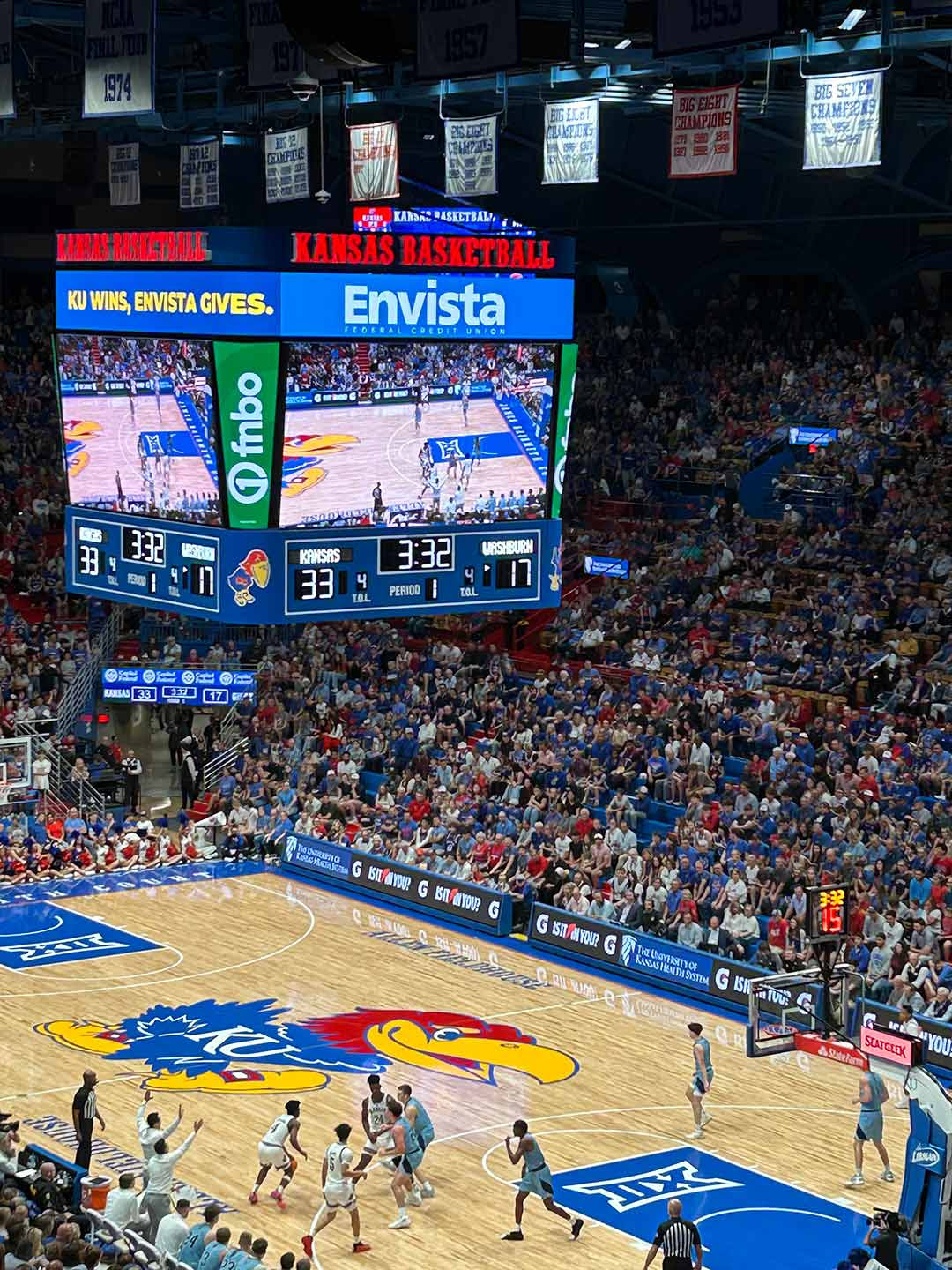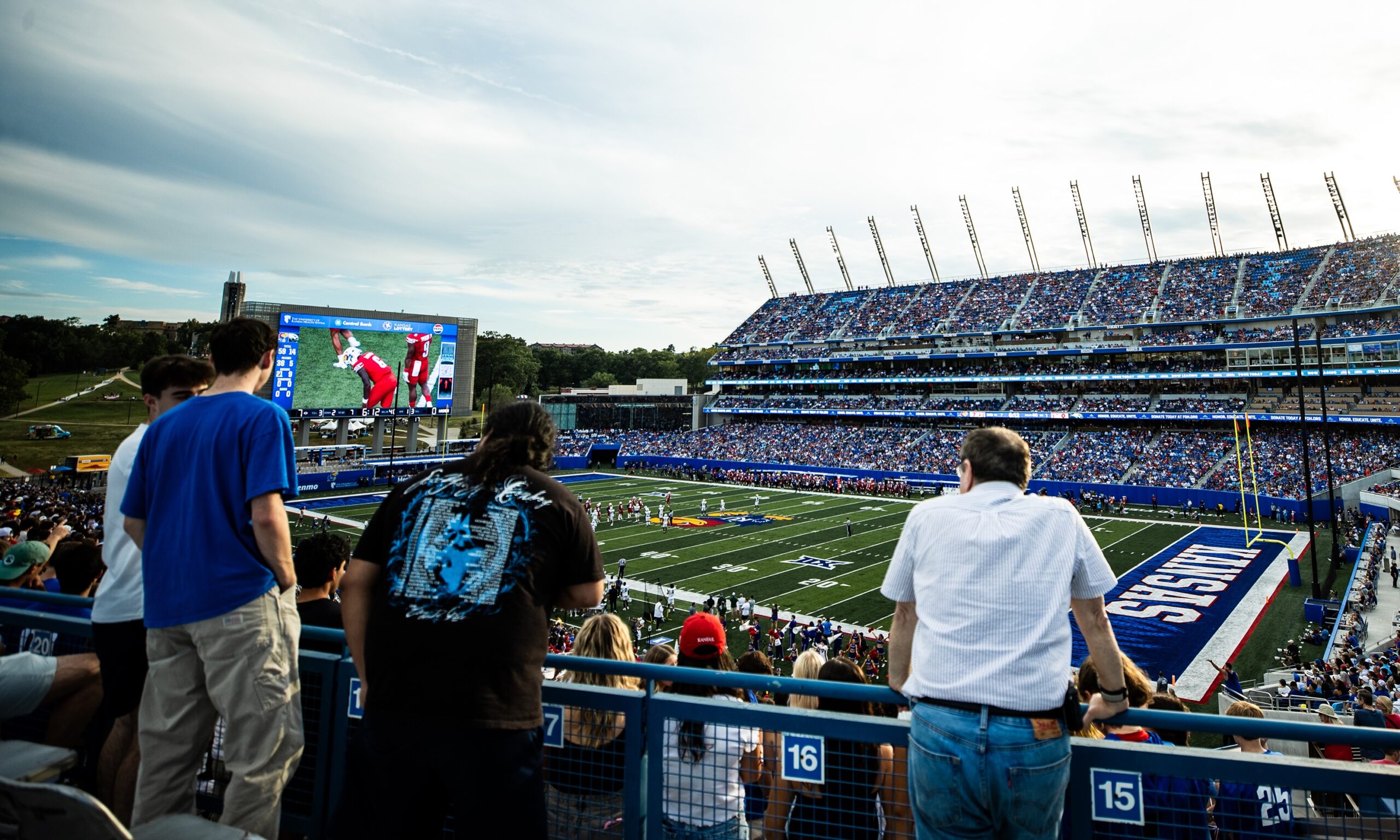Rock Chalk Rebuild, Part 2: A Pro’s Guide to Kansas Athletics’ New Video-Production Infrastructure
Ross, Evertz, Daktronics backbone unifies next-gen control rooms, truck, stadium displays
Story Highlights
When the University of Kansas reopened David Booth Kansas Memorial Stadium this summer, it grabbed the spotlight as one of the newest power-conference college football venues in the country. Behind that on-field spectacle, however, sits one of the most ambitious collegiate broadcast-technology integrations in recent memory: a multi-phase rebuild of every control room and production system operated by Kansas Athletics’ video-production arm, Rock Chalk Video.

The rebuild of David Booth Kansas Memorial Stadium is the centerpiece of the University of Kansas’s Gateway District, massive, multi-year development project. (Photos: Kansas Athletics)
Since 2023, Kansas Athletics — led by Rock Chalk Video and longtime integration partner Alpha — rebuilt the entirety of its video-production ecosystem. The work spanned Allen Fieldhouse, the university’s 53-ft. production truck, and the new football control room.
For Mike Lickert, associate athletic director, Rock Chalk Video, the reality of the upgrade began with an honest audit of aging systems. “Whether good or bad, we had multiple aging control rooms. Some of the glass we were using was 25 years old,” he says. “We updated two control rooms in Allen Fieldhouse: one that runs the videoboard for men’s and women’s basketball; the other, right next to it, is for ESPN+. We are able to do things in our shows now that we weren’t able to do before.”
The Allen Fieldhouse refresh followed the truck retrofit and preceded the football-stadium reconstruction, establishing a design philosophy that now defines Rock Chalk Video: modern, consistent, and scalable workflows that behave the same way no matter which venue a show originates from.
A Three-Phase Build With Alpha
For Alpha, the Kansas project is another chapter in a long partnership. The integrator has delivered multiple generations of KU control rooms. This project required a more segmented engineering approach given the physical separation of the major venues. Allen Fieldhouse sits in the heart of campus; the football stadium does not. That distance shaped the production strategy from the ground up.
“It’s difficult to get fiber and other infrastructure between the two locations,” notes Jeff Volk, VP, Sports & Entertainment Group, Alpha. “So football has to have its own self-contained solution over at the football stadium.”
Kansas enlisted engineering consultant WJHW to produce the technical specification for the stadium renovation, but, as with many publicly funded capital projects, schedules tightened fast.
“After all of that came together, the timeline had to move very, very quickly,” Volk says. “I don’t think we came under a contract until, I want to say March or April, which is very, very late to get that all up and running and ready to go in July. It came down to the wire, but it sure got done.”
Experienced Engineering Muscle on Campus
Although Alpha led design and integration, Lickert stresses that the execution relied heavily on campus-side engineering led by KU Athletics Director, Broadcast Engineering, Andy Leslie. “Andy did monumental amounts of work throughout the four control rooms to get it done,” says Lickert.
Volk echoes that sentiment, noting that long-tenured in-house engineers are critical when construction timelines compress. “Having people that have been working either as a contractor to athletics or directly for athletics for long periods know where all the bodies are buried around campus and how to get things done. They fully understand what we’re trying to get done on these very short timelines.”
Kansas also benefited from the project’s sequencing. Long before the new football room went live, the team had a full year of experience with the refreshed Allen Fieldhouse rooms and the upgraded truck.
“Everyone essentially had a year of using all the same equipment at Allen Fieldhouse and in their production trailer,” Volk says. “The production staff and the engineering staff are intimately familiar with all the gear. The only things you have to worry about are how the room is laid out differently, how the productions flow a little bit differently.”
Building Consistency Across Multiple Production Facilities
At the center of KU’s new infrastructure is a unified Ross Video backbone. Each major control environment — football, the dual rooms in Allen Fieldhouse, the mobile unit — runs on a Ross Carbonite Ultra 60 engine with a TouchDrive 3M/E panel. Each facility also has its own Ross Ultrix FR12 frame, loaded with HDX I/O, UltriMix audio, and tally integration. UltriCore licensing and RCP-QE36 control panels unify the operator experience regardless of location.
Volk says the goal was straightforward: “They have common systems that [users] get familiar with across the board.”
Kansas relies heavily on Ultrix’s integrated multiview architecture. Sixteen UltriScape licenses power custom layouts tailored to each control room’s needs and workflow.

A new centerhung videoboard at Allen Fieldhouse debuted a year ago as part of the multi-year project.
Replay consistency was another priority. Across football, basketball, and the truck, Kansas standardized on Evertz DreamCatcher, building an HDR-capable 1080p/60 baseband environment. DreamCatcher cores include continuous-record licenses, playout channels, and linear-playout keys for videoboard shows. An Evertz Scorpion IPX platform provides flexible media transport across venues.
The three sites — Allen Fieldhouse, football control room, truck — are independent but interconnected. Cameras are shared between venues; control rooms remain fully self-contained. “But, from a control-room perspective, all those units are self-contained,” Volk explains. “We tried to design and build as much familiarity and redundancy into all the systems as possible.”
For a student-heavy operation, that consistency has operational value. “We use a lot of students,” Lickert notes. “It was important for us to have unity throughout the control room so they could go in and, if they’re doing replay in the truck, it’s the same as what they’re doing in the ESPN room, same as what they’re doing at football and basketball.”
The football control-room build offered unique opportunities because it was constructed simultaneously with the stadium itself. “[We’re] really happy with it,” Lickert says. “Not a lot of people get to build a totally new football stadium. We blew it up to the ground and started over. You have to think not about Opening Day but about five or six games into it, your day-to-day.”
Conversion, Distribution, Fiber Transport
Signal flow among venues, truck docks, and field positions is supported by a deep layer of conversion and transport hardware from Ross, AJA, Decimator, and Thor Fiber.
Kansas deployed Ross openGear OGX frames with reclocking and DA cards, AJA FS-HDR processors for format management, and a mix of AJA FiDO and Thor Fiber extenders for long-run SDI transport. Fiber infrastructure comprises Joseph Electronics SMPTE hybrid assemblies, BitTree patching systems, and Clark Wire maintenance tools.
Reference and timing are driven by Telestream SPG9000 master sync generators with GNSS, PTP, and SD/HD/UHD test-signal licensing, supported by ECO8000 changeover frames. Engineering monitoring is handled through Leader LV7300 and LV7600W rasterizers.
Audio, Intercom, Monitoring, Power
KU’s audio backbone is fully Dante-enabled, built around Yamaha TF5 consoles with NY64-D cards, Ferrofish Verto MX bridges, and Studio Technologies interfaces. Analog distribution and word-clock handling are supported through Ross openGear.
Intercom is anchored by RTS ODIN matrix frames and ROAMEO wireless beltpacks, extended through outdoor-rated enclosures and PoE distribution for stadium-wide coverage.
Operators work from Forecast Consoles MasterVision furniture with ASUS ProArt displays, Plura and Ikegami reference monitors, TVLogic rack units, and Sony BRAVIA 4K HDR multiview screens. Equipment is housed in Middle Atlantic VMRK 54RU racks protected by APC Smart-UPS power systems.


